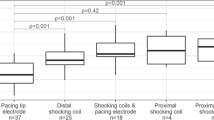Abstract
Both leads and pulse generators of implantable defibrillators have undergone important improvements during the last years. New leads should be tested against previous models to demonstrate safety and reliability. When introduced in 1995, the Medtronic 6932 pace, sense and defibrillation lead was compared to the alternative larger 6936 lead in a short-term randomized study with a mean follow-up of 2.4±2.0 months. A subgroup of patients were followed for 23.9±9.0 months. Three hundred and thirty-six patients were randomized to receive either the 6932 or the 6936 lead. Defibrillation threshold at implant, tested using a binary search protocol, was similar for the two leads. The pacing threshold was significantly lower for the 6932 lead both at implant and at follow-up, probably due to the steroid eluting tip of the electrode. R-wave amplitudes were similar for the leads, as were the complication rates. During about two years of follow-up, both leads performed well, with a slightly lower pacing threshold for the 6932 lead.
Similar content being viewed by others
References
Liang KY, Zeger SL. Longitudinal data analysis using generalized linear models. Biometrika 1986; 73: 13–22.
Mond HG, Stokes KB. The steroid eluting electrode. A 10-years experience. Pacing Clin Electrophysiol 1996; 19: 1016–1020.
Schwartzman D et al. Postoperative lead-related complications in patients with nonthoracotomy defibrillation lead systems. J Am Coll Cardiol 1995; 26: 776–786.
Fahy G et al. Low incidence of lead related complications associated with nonthoracotomy implantable cardioverter defibrillator lead systems. Pacing Clin Electrophysiol 1995; 18: 172–178.
Author information
Authors and Affiliations
Corresponding author
Rights and permissions
About this article
Cite this article
Aass, H., Ilvento, J. Short and Medium Time Experience with a Tined, Multilumen Steroid Eluting Defibrillation Lead. J Interv Card Electrophysiol 6, 81–86 (2002). https://doi.org/10.1023/A:1014184425250
Issue Date:
DOI: https://doi.org/10.1023/A:1014184425250




